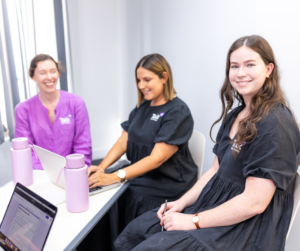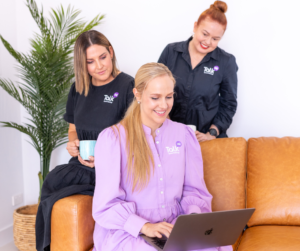I think you’ll agree that establishing joint attention is vital for developing children’s social communication and cognitive skills. In neurotypical children, joint attention skills start to develop soon after birth. At 18 months of age, toddlers are usually competent at gaining and maintaining joint attention from adults and peers. Without joint attention skills, it could be difficult for children to interact and develop relationships with their caregivers and peers. Joint attention helps develop important play skills, language skills and perspective-taking skills.
Here, I share my six favourite games I play with children in my therapy sessions to support joint attention. These are great tools, especially if the child is very difficult to engage with.
Therapy Game Number 1.
My first number one tip is as simple as it gets: Peekaboo.
You can either play this joint attention therapy game very simply with your hands, or you can put a light tissue or a little cloth over your face, and then pull it down for the “Boo”. You can extend the joint attention by increasing the play partners. For example, you cover your face first and then put the list cloth over the parent’s face. Finally, if the child allows it, you could give them the cloth and see if they try to cover their face too. In this way, it is a nice way to include the parents in the therapy session. It also demonstrates how this game can easily be done at home. For these reasons, Peekaboo is a fantastic game to support joint attention in play.
Therapy Game Number 2.
My second favourite joint attention game is singing and moving to the song “Row Row Row Your Boat”. I find kids love this game because it’s a movement game. When I sing this song, I actually get down on the floor and place the child in my lap. I sing and gently rock the child back and forth in time with the song. I find many of my autistic kids find the rocking motion is actually quite soothing for them. They really like it! After a few rocks or at the song’s end, I pause and wait for them to communicate. They may communicate their wants with a head turn, or they might move their body themselves. These movements are meaningful, and we need to respond appropriately. If you’re feeling slightly uncomfortable touching the child, you can demonstrate the activity with a doll. Then, you can ask the parent to come down to the floor with their child and practice alongside you. This song activity is such a fun way to help with joint attention. I have found that even kids who can be tricky to engage love this therapy game.
Therapy Game Number 3.
Another simple game is playing “Round and Round The Garden”. Children love this finger-play activity, and it’s a great way to teach cause and effect. You simply start drawing circles with your index finger on their palm while saying, ‘Round and round the garden like a teddy bear. One step, two steps, and then tickly under there’. The children quickly learn the sequence. Then they start expecting the tickle. They may indicate joint attention simply because they put their hand forward in your direction. Joint attention does not have to mean eye contact. It can be shared facial expressions, gestures or even head turns. These behaviours all communicate that they are wanting to engage in this one shared activity.
Therapy Game Number 4.
Game 4 is another movement-style game that supports joint attention: Ring a Ring a Rosie. This is therapy game is particularly great for your active kids. That is, children who seek movement but they don’t want to necessarily engage with you. I like to make this movement game very animated. When it is time for “We all fall down’, I gently place the child down and then I dramatically throw myself down on the ground next to them. I find that because the play is so animated they want to play again. You can further support joint attention when you “freeze”. You lay frozen on the ground until the child indicates some form of communication for you to get up. I find this is a great technique to support joint attention.
Therapy Game Number 5.
“Open, Close Them” is another fun favourite we can use to support joint attention in children. It’s a simple action song of opening and closing your hands while singing the song: ‘Open, close them, open close them, give a little clap’. Sometimes if the child is open to it, you can use their hands to clap. Repeat, ‘Open, close them, open, close them, place them in your lap’. Next, I try to use their hands (if they can tolerate my touch), to step up their body to their chin, while singing, ‘Creep them, creep them, creep them, creep them, right up to your chin’. Then I sing, ‘Open up your mouth, but then’ and pause. When I sing, ‘Do not let them in,’ I tickle them under the chin, and the children love it. However, kids who are tactile defensive may find this activity too much for their sensory system. If this is the case, the whole-body kinds of activities would be better suited.
Therapy Game Number 6.
For children sensitive to touch, you can adapt the Peekaboo activity by using a weighted blanket or something similar. Then you can wrap them up in it, give them a nice, big squeeze, and then open it up and say “Boo!”. This therapy game can also be a nice little people game and really effective for joint attention.
Conclusion
I have found that these types of therapy games help children with developmental delays and/or autism build joint attention skills. If you’re currently studying Speech Pathology or are qualified, you can easily implement these therapy ideas in your early language therapy sessions. At Talk HQ, our dedicated team of Senior Speech Pathologists help upskill our early career speech pathologists by explicitly demonstrating therapy games such as these to help them learn how to target joint attention skills in therapy.
Want to learn more about paediatric speech pathology? Join our Student Hangout Facebook Group, specifically created for Speech Pathology Students who are currently studying and are passionate about our industry.
If you want a workplace that prioritises supporting your learning to provide quality therapy sessions, upload your resume today.
Written by Julie Sexton, CEO and Senior Speech Pathologist at TalkHQ.







